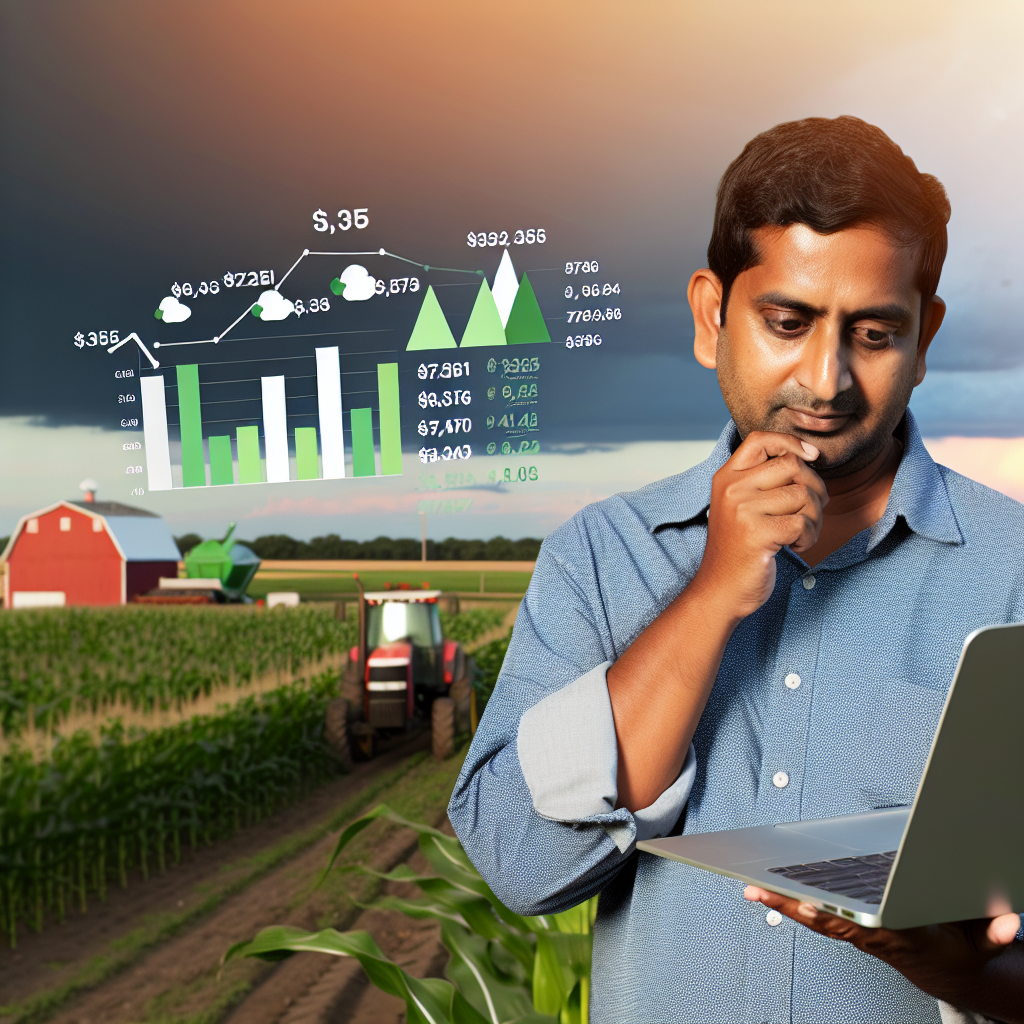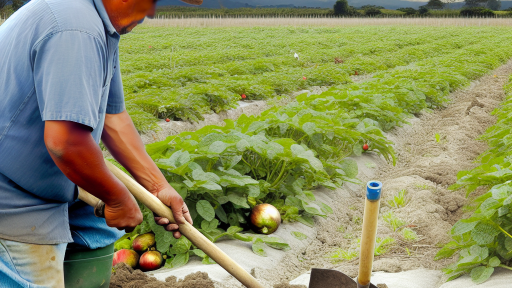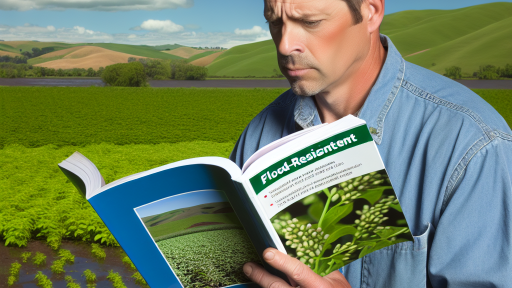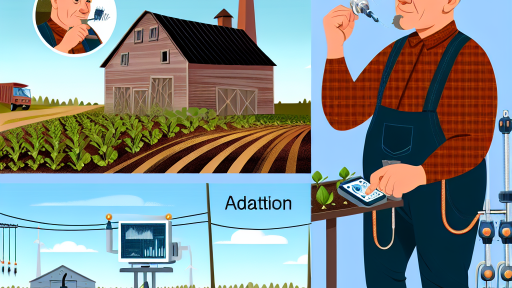Introduction to Climate Variability in Agriculture
Climate variability significantly affects agricultural practices worldwide.
Farmers must adapt to changing weather patterns each season.
This variability can mean more droughts or unexpected heavy rains.
Such shifts directly impact crop yields and quality.
Understanding Climate Variability
Climate variability refers to fluctuations in climate patterns over time.
It encompasses changes in temperature, precipitation, and extreme weather events.
Farmers often struggle to predict these changes accurately.
This unpredictability poses risks to their livelihoods.
The Role of Agriculture
Agriculture plays a crucial role in feeding the global population.
As a significant sector, it contributes to many economies.
However, agriculture is also inherently vulnerable to climate changes.
Adapting practices is essential for sustainability.
Significance of Climate Variability
Understanding climate variability is vital for effective farming.
Farmers can make informed decisions based on climate forecasts.
This knowledge aids in planning for planting and harvesting seasons.
Transform Your Agribusiness
Unlock your farm's potential with expert advice tailored to your needs. Get actionable steps that drive real results.
Get StartedFurthermore, it influences water management strategies.
Impacts on Financial Stability
Climate variability can lead to substantial financial losses for farms.
Crops affected by adverse weather often result in lower profits.
Consequently, farmers may face higher production costs.
This cycle creates long-term implications for their financial health.
Overview of Financial Metrics Relevant to Assessing Farm Impacts
Understanding financial metrics is crucial for farmers facing climate variability.
These metrics offer insights into profitability and sustainability.
Farmers must track various financial indicators to gauge their economic health.
Revenue Analysis
Revenue serves as a primary metric for assessing farm performance.
It reflects the total income generated from selling crops and livestock.
Analyzing revenue trends helps farmers identify potential issues.
For instance, fluctuations in crop prices may indicate market volatility.
Cost Management
Effective cost management enhances overall farm profitability.
Farmers should monitor both fixed and variable costs closely.
Fixed costs include expenses related to land, equipment, and infrastructure.
In contrast, variable costs involve inputs like seeds, labor, and fertilizers.
By reducing unnecessary expenses, farmers can improve their financial position.
Profit Margins
Profit margins indicate the relative profitability of farm operations.
Calculating profit margins involves assessing revenue against total costs.
A declining profit margin may signal economic strain due to climate impacts.
Farmers should strive to maintain healthy margins for sustainability.
Cash Flow Management
Cash flow management directly affects a farm’s operational capacity.
Positive cash flow ensures farmers can meet their financial obligations.
Monitoring cash inflows and outflows helps in planning for future investments.
Showcase Your Farming Business
Publish your professional farming services profile on our blog for a one-time fee of $200 and reach a dedicated audience of farmers and agribusiness owners.
Publish Your ProfileFarmers facing climate variability should prepare for potential cash shortfalls.
Return on Investment (ROI)
ROI measures the profitability of specific farming investments.
Evaluating ROI helps farmers make informed decisions on resource allocation.
Investments in sustainable practices may yield long-term benefits.
Debt-to-Equity Ratio
The debt-to-equity ratio assesses a farm’s financial leverage.
A high ratio may indicate excessive debt levels, posing risks.
Farmers should aim for a balanced approach to financing their operations.
Insurance Coverage
Appropriate insurance coverage protects against unexpected losses.
Farmers should consider policies that address climate-related risks.
Insurance can mitigate the financial impacts of crop failure or property damage.
Investment in Technology
Investing in technology can enhance productivity and efficiency.
Precision farming tools provide data-driven insights for better decision-making.
Farmers should evaluate the cost-benefit analysis of adopting new technologies.
Long-Term Financial Planning
Long-term financial planning supports resilience against climate variability.
Farmers should create budgets that account for potential environmental changes.
Setting aside funds for emergencies can provide a safety net.
Identifying the Main Climate Variables Affecting Farming
Temperature Variability
Temperature directly influences crop growth and development.
Higher temperatures can accelerate maturation, impacting yield.
Conversely, lower temperatures may stunt growth and delay harvest.
Farmers need to monitor local temperature trends carefully.
Winter conditions can significantly affect plant survival rates.
Precipitation Patterns
Precipitation is crucial for sustaining crops throughout their growth cycles.
Both droughts and excessive rainfall can lead to crop failures.
Farmers must understand their region’s precipitation patterns.
Optimal irrigation strategies can mitigate the effects of less rainfall.
Conversely, drainage systems are vital in areas prone to flooding.
Wind Exposure
Wind impacts soil moisture and can cause physical damage to crops.
Strong winds can lead to increased evaporation rates in dry conditions.
Farmers should plant windbreaks to protect delicate crops.
Identifying local wind trends helps improve farming strategies.
Humidity Levels
Humidity affects plant transpiration and nutrient uptake.
High humidity can promote disease in crops and reduce yields.
Understanding local humidity trends is essential for crop selection.
Farmers may need to adjust their practices based on humidity data.
Soil Conditions
Soil quality is influenced by moisture levels and temperature.
Additionally, soil composition varies by geographic region.
Healthy soil promotes beneficial microbial activity for crops.
Farmers should regularly test their soil for nutrient availability.
Improving soil conditions can enhance resilience against climate impacts.
See Related Content: Precision Agriculture Tools for Better Water Management
Showcase Your Farming Business
Publish your professional farming services profile on our blog for a one-time fee of $200 and reach a dedicated audience of farmers and agribusiness owners.
Publish Your ProfileCase Studies: Historical Financial Impacts of Climate Variability on Farms
Overview of Climate Variability
Climate variability significantly influences farming operations worldwide.
Farmers experience both direct and indirect effects from changing weather patterns.
These impacts can lead to shifts in crop yields and livestock productivity.
Over time, these changes may affect the financial stability of farm operations.
Impact of Drought on Crop Yields
Drought is one of the most severe forms of climate variability.
It reduces available water for crops, leading to lower yields.
For example, in 2012, drought devastated corn crops in the United States.
Farmers reported losses exceeding nine billion dollars due to this event.
This financial toll forced many farms to alter their operations, including crop selection.
Flooding and Its Effects
On the opposite end, flooding also poses a significant risk to agriculture.
Excessive rainfall can destroy crops and damage soil structure.
In 2010, floods in Pakistan affected millions of acres of farmland.
The financial losses reached approximately five billion dollars nationwide.
Farmers faced immense challenges in recovering from such events.
Temperature Extremes and Their Consequences
Temperature extremes further complicate farming practices.
Excessive heat, for instance, can harm crop development and reduce yields.
In 2015, high summer temperatures led to a substantial decline in wheat production.
Farmers navigating these challenges often incur higher costs for water and labor.
Long-Term Financial Trends
Over the decades, the cumulative financial impact of climate variability becomes alarming.
Farmers have had to adapt to unexpected changes, often leading to increased costs.
Moreover, recurring weather events can destabilize farm economies.
Consequently, many farms shift towards more sustainable practices.
This adaptation aims to mitigate future financial losses due to climate extremes.
Case Study Examples
- The Smith Family Farm in California faced severe drought in 2014.
- They reported a 40% yield reduction in their almond production.
- The Johnson Ranch in Texas experienced flooding in 2018.
- They faced over a million dollars in losses due to destroyed crops.
These examples underscore the pressing need for action against climate variability.
Discover More: Sustainable Farming Techniques for Unpredictable Weather
Quantitative Methods for Assessing Financial Impacts
Introduction to Financial Assessment
Farmers increasingly face the challenge of assessing financial impacts arising from climate variability.
To address this, quantitative methods offer valuable insights.
These methods can effectively model potential outcomes and forecast future scenarios.
Modeling Techniques
Modeling serves as a foundational tool in assessing financial impacts.
It allows farmers to simulate various climate conditions and their economic consequences.
For example, the AquaCrop model estimates yield responses to water availability.
This model helps farmers determine the optimal irrigation strategies to minimize financial losses.
Moreover, other models like DSSAT assess crop growth under diverse weather patterns.
Forecasting Financial Outcomes
Forecasting plays a crucial role in making informed financial decisions.
With accurate predictions, farmers can better prepare for potential losses.
Statistical techniques, such as time series analysis, are commonly used for forecasting.
These methods analyze historical data to predict future trends effectively.
By understanding these trends, farmers can adjust their practices proactively.
Risk Assessment and Management
Risk assessment is essential for understanding financial vulnerabilities.
Farmers can use models like the Monte Carlo simulation to evaluate risks.
Showcase Your Farming Business
Publish your professional farming services profile on our blog for a one-time fee of $200 and reach a dedicated audience of farmers and agribusiness owners.
Publish Your ProfileThis simulation helps quantify the likelihood of various climate scenarios impacting yields.
Additionally, sensitivity analysis identifies which variables most significantly affect financial outcomes.
By recognizing these variables, farmers can prioritize strategies for risk management.
Cost-Benefit Analysis
Conducting a cost-benefit analysis aids in evaluating adaptation measures.
This analysis compares the financial costs of implementing changes against projected benefits.
For instance, a farmer may analyze the cost of investing in drought-resistant crops.
Such analysis helps determine if potential yields justify the investment.
Data Quality and Sources
Data quality significantly influences the accuracy of models and forecasts.
Farmers should prioritize using high-quality, localized data for the best outcomes.
Government databases and agricultural research institutions provide valuable information.
Moreover, integrating field data enhances the reliability of assessments and forecasts.
Implications of Quantitative Methods
Utilizing quantitative methods empowers farmers to assess financial impacts effectively.
These approaches lead to better decision-making under climate variability.
Establishing a robust methodology can safeguard farmers’ financial futures.
See Related Content: Farmers’ Toolkit for Climate Adaptation Success

Qualitative Impacts of Climate Variability on Farming Operations and Planning
Changes in Crop Viability
Climate variability significantly influences crop viability on farms.
Unexpected weather events can hinder crop growth.
Farmers often face challenges in predicting suitable planting and harvesting times.
This unpredictability leads to a risk of reduced yields.
Therefore, understanding local climate trends becomes essential.
Impact on Soil Quality
Soil quality suffers from erratic climate conditions.
Increased rainfall can lead to soil erosion.
Drought conditions may diminish soil moisture levels.
Consequently, farmers may struggle to maintain soil fertility.
Thus, implementing sustainable soil management practices is critical.
Effects on Pest and Disease Dynamics
Climate variability can alter pest and disease patterns significantly.
Warmer temperatures may enable pests to thrive.
Conversely, unpredictable climates may reduce pest populations at times.
This inconsistency complicates integrated pest management strategies.
As a result, farmers must adapt their approaches regularly.
Challenges in Resource Management
Water resource management becomes increasingly complex due to climate variability.
Farmers often need to adjust irrigation practices based on unpredictable rainfall.
This adjustment requires both time and financial investment.
Additionally, fluctuating temperatures can impact water availability.
Consequently, effective resource planning is vital for farm sustainability.
Long-term Strategic Planning
Climate variability forces farmers to rethink long-term strategies.
Planning must include potential climate risks and uncertainties.
Farmers are encouraged to diversify crops for better resilience.
Moreover, they should consider investment in climate-smart agriculture techniques.
This proactive approach can enhance overall farm viability.
Showcase Your Farming Business
Publish your professional farming services profile on our blog for a one-time fee of $200 and reach a dedicated audience of farmers and agribusiness owners.
Publish Your ProfileYou Might Also Like: Economic Strategies for Climate-Resilient Agricultural Practices
Strategies for Mitigating Financial Risks Associated with Climate Variability
Understanding Financial Risks
Climate variability poses significant financial risks for farmers.
These risks can lead to reduced crop yields and increased operational costs.
Moreover, unpredictable weather patterns complicate effective planning.
Diverse Crop Cultivation
Diversifying crop production helps spread financial risk.
Farmers can adapt to changing conditions by planting various crops.
This strategy enhances resilience against climate shocks.
Additionally, it opens opportunities for different revenue streams.
Implementing Sustainable Practices
Sustainable farming practices bolster long-term viability.
Methods such as organic farming improve soil health and productivity.
They also reduce dependence on chemical inputs, lowering costs.
Farmers should consider implementing crop rotation and cover cropping.
Insurance and Financial Tools
Crop insurance serves as an essential safety net.
Farmers must evaluate different insurance options available to them.
Weather-indexed insurance can provide quick, reliable payouts.
Additionally, securing loans with favorable terms can assist during tough seasons.
Investment in Technology
Utilizing modern agricultural technology enhances productivity.
Precision agriculture methods optimize resource use and reduce waste.
Farmers can benefit from data analytics to predict weather patterns.
Moreover, investing in irrigation systems mitigates drought risks.
Collaboration and Networking
Forming cooperatives among farmers can amplify resources.
Collaboration aids in sharing knowledge and best practices.
Networking also creates access to bulk purchasing and lower costs.
Educating and Training
Continuous education is crucial for adapting to climate change.
Farmers should attend workshops and training sessions.
These programs equip them with the latest strategies and techniques.
Knowledge sharing fosters community resilience and innovation.
Government Assistance and Policies
Farmers should stay informed about available government programs.
Subsidies can ease the burden of transitioning to sustainable practices.
Advocating for influential policy changes supports the agricultural sector.
Engaging with local officials can foster better support systems.
Policy Implications and Government Support for Affected Farmers
Identifying the Challenges
Farmers face numerous challenges due to climate variability.
Extreme weather events disrupt planting and harvesting seasons.
Increased pest and disease outbreaks threaten crop yields.
Farmers also deal with fluctuating market prices due to supply chain disruptions.
Government Response Strategies
Governments implement various strategies to support farmers.
Financial assistance programs help stabilize farm income during crises.
Emergency relief funds provide immediate support after disasters.
Crop insurance programs mitigate losses from unexpected events.
Promoting Resilience through Policy
Long-term policies focus on building resilience in agriculture.
Showcase Your Farming Business
Publish your professional farming services profile on our blog for a one-time fee of $200 and reach a dedicated audience of farmers and agribusiness owners.
Publish Your ProfileInvestment in research helps develop climate-resistant crop varieties.
Supporting sustainable farming practices reduces vulnerability to climate impacts.
Farmers receive training in adaptive techniques to manage changing conditions.
Collaboration with Agricultural Organizations
Collaboration between governments and organizations is vital.
Partnerships enhance resource sharing and knowledge dissemination.
Organizations like the American Farm Bureau Federation advocate for farmer needs.
Furthermore, initiatives like the USDA Climate Hubs offer targeted resources.
Community Engagement and Support Networks
Building community networks fosters local support for farmers.
Farmers can share resources and strategies for coping with climate impacts.
Community-supported agriculture programs strengthen local economies.
Additionally, educational workshops empower farmers with knowledge.




